Transnuclear TRP1-specific CD8 T cells with high or low affinity TCRs show equivalent antitumor activity
- PMID: 24459675
- PMCID: PMC3895912
- DOI: 10.1158/2326-6066.CIR-13-0047
Transnuclear TRP1-specific CD8 T cells with high or low affinity TCRs show equivalent antitumor activity
Abstract
We have generated, via somatic cell nuclear transfer, two independent lines of transnuclear (TN) mice, using as nuclear donors CD8 T cells, sorted by tetramer staining, that recognize the endogenous melanoma antigen TRP1. These two lines of nominally identical specificity differ greatly in their affinity for antigen (TRP1(high) or TRP1(low)) as inferred from tetramer dissociation and peptide responsiveness. Ex vivo-activated CD8 T cells from either TRP1(high) or TRP1(low) mice show cytolytic activity in 3D tissue culture and in vivo, and slow the progression of subcutaneous B16 melanoma. Although naïve TRP1(low) CD8 T cells do not affect tumor growth, upon activation these cells function indistinguishably from TRP1(high) cells in vivo, limiting tumor cell growth and increasing mouse survival. The anti-tumor effect of both TRP1(high) and TRP1(low) CD8 T cells is enhanced in RAG-deficient hosts. However, tumor outgrowth eventually occurs, likely due to T cell exhaustion. The TRP1 TN mice are an excellent model for examining the functional attributes of T cells conferred by TCR affinity, and they may serve as a platform for screening immunomodulatory cancer therapies.
Keywords: B16; T cell receptor; melanoma; somatic cell nuclear transfer; tyrosinase related protein 1.
Conflict of interest statement
Conflict of interest: SO is an employee of Janssen Pharmaceuticals. The authors have no other conflicts of interest to disclose.
Figures
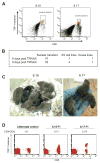
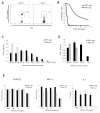
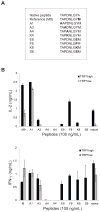

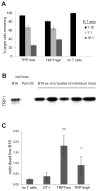
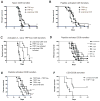

Similar articles
-
Altered Binding of Tumor Antigenic Peptides to MHC Class I Affects CD8+ T Cell-Effector Responses.Cancer Immunol Res. 2018 Dec;6(12):1524-1536. doi: 10.1158/2326-6066.CIR-18-0348. Epub 2018 Oct 23. Cancer Immunol Res. 2018. PMID: 30352798 Free PMC article.
-
Manipulation of avidity to improve effectiveness of adoptively transferred CD8(+) T cells for melanoma immunotherapy in human MHC class I-transgenic mice.J Immunol. 2001 Nov 15;167(10):5824-31. doi: 10.4049/jimmunol.167.10.5824. J Immunol. 2001. PMID: 11698456
-
Lentivector immunization stimulates potent CD8 T cell responses against melanoma self-antigen tyrosinase-related protein 1 and generates antitumor immunity in mice.J Immunol. 2009 May 15;182(10):5960-9. doi: 10.4049/jimmunol.0900008. J Immunol. 2009. PMID: 19414747 Free PMC article.
-
Both CD4 and CD8 T cells mediate equally effective in vivo tumor treatment when engineered with a highly avid TCR targeting tyrosinase.J Immunol. 2010 Jun 1;184(11):5988-98. doi: 10.4049/jimmunol.1000189. Epub 2010 Apr 28. J Immunol. 2010. PMID: 20427771 Free PMC article.
-
Adoptive T Cell Therapy with IL-12-Preconditioned Low-Avidity T Cells Prevents Exhaustion and Results in Enhanced T Cell Activation, Enhanced Tumor Clearance, and Decreased Risk for Autoimmunity.J Immunol. 2020 Sep 1;205(5):1449-1460. doi: 10.4049/jimmunol.2000007. Epub 2020 Jul 31. J Immunol. 2020. PMID: 32737148 Free PMC article.
Cited by
-
Peptide-MHC Class I Tetramers Can Fail To Detect Relevant Functional T Cell Clonotypes and Underestimate Antigen-Reactive T Cell Populations.J Immunol. 2018 Apr 1;200(7):2263-2279. doi: 10.4049/jimmunol.1700242. Epub 2018 Feb 26. J Immunol. 2018. PMID: 29483360 Free PMC article.
-
Divergent fates of antigen-specific CD8+ T cell clones in mice with acute leukemia.Cell Rep. 2021 Nov 9;37(6):109991. doi: 10.1016/j.celrep.2021.109991. Cell Rep. 2021. PMID: 34758311 Free PMC article.
-
Expression of modified FcγRI enables myeloid cells to elicit robust tumor-specific cytotoxicity.Elife. 2024 Jun 17;12:RP91999. doi: 10.7554/eLife.91999. Elife. 2024. PMID: 38885133 Free PMC article.
-
cIAP1/2 Antagonism Induces Antigen-Specific T Cell-Dependent Immunity.J Immunol. 2023 Apr 1;210(7):991-1003. doi: 10.4049/jimmunol.2200646. J Immunol. 2023. PMID: 36881882 Free PMC article.
-
Sustained Persistence of IL2 Signaling Enhances the Antitumor Effect of Peptide Vaccines through T-cell Expansion and Preventing PD-1 Inhibition.Cancer Immunol Res. 2018 May;6(5):617-627. doi: 10.1158/2326-6066.CIR-17-0549. Epub 2018 Feb 26. Cancer Immunol Res. 2018. PMID: 29483127 Free PMC article.
References
-
- Galon J, Costes A, Sanchez-Cabo F, Kirilovsky A, Mlecnik B, Lagorce-Pages C, et al. Type, density, and location of immune cells within human colorectal tumors predict clinical outcome. Science. 2006;313(5795):1960–4. - PubMed
-
- Dougan M, Dranoff G. Immune therapy for cancer. Annu Rev Immunol. 2009;27:83–117. - PubMed
Publication types
MeSH terms
Substances
Grants and funding
LinkOut - more resources
Full Text Sources
Other Literature Sources
Molecular Biology Databases
Research Materials

